Comprehensive Case Study: Drug Therapy for Asthma and Graves' Disease
VerifiedAdded on 2022/08/25
|11
|2569
|22
Case Study
AI Summary
This case study examines a patient, Jolene, presenting with symptoms of tachycardia, tachypnoea, and anxiety, leading to a discussion of drug therapies for asthma and Graves' disease. The assignment explores the pathophysiology of asthma, details the generic information, indications, and actions of medications like Ventolin, Serevent, and Atrovent, and explains Graves’ disease and its antithyroid drug treatment. It further analyzes the rationale behind combining beta-blockers with antithyroid drugs, while also addressing potential interactions with bronchodilators. Finally, the case study concludes with a simulated nurse-patient conversation about pregnancy, providing professional advice considering ethical codes and standards.
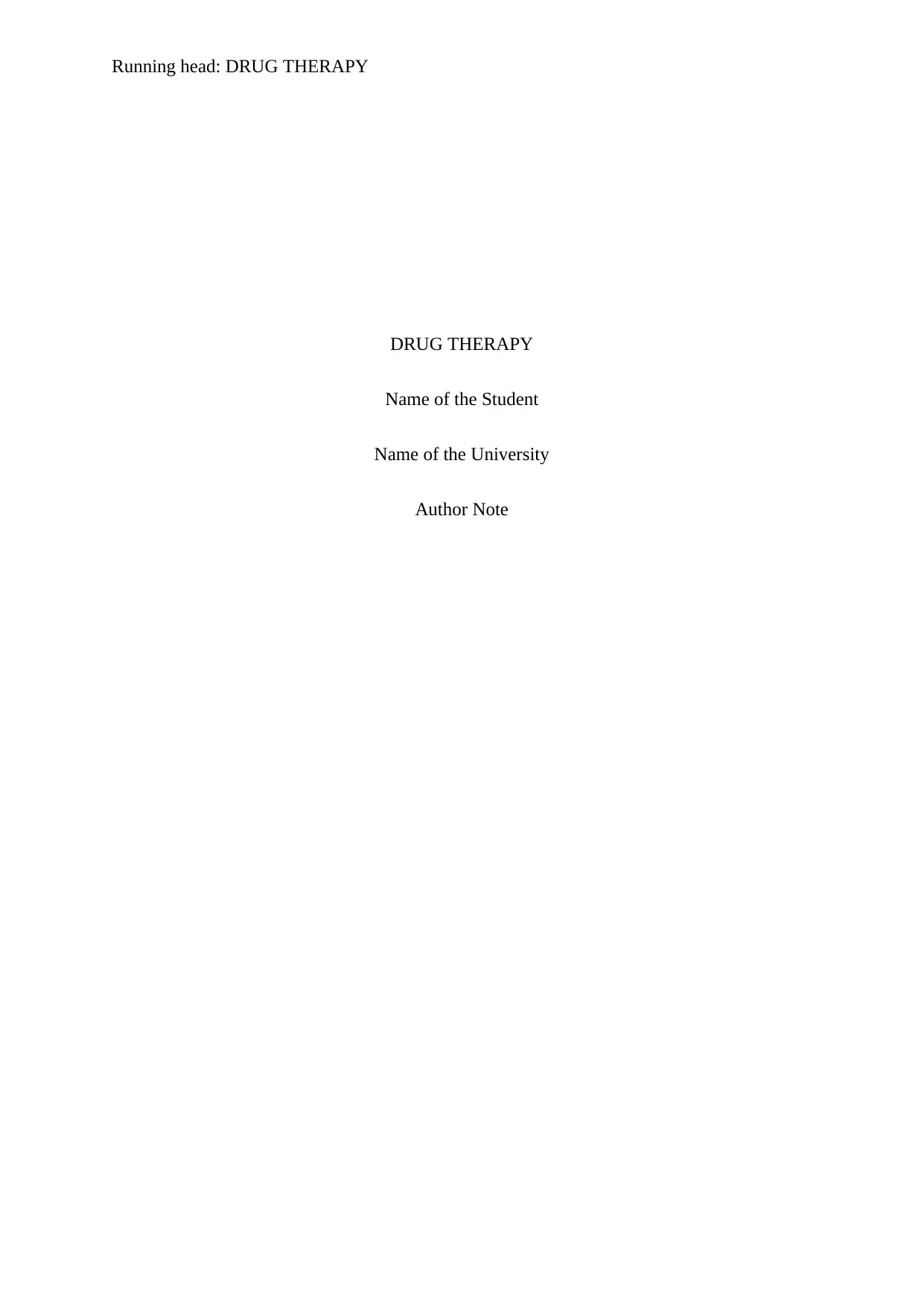
Running head: DRUG THERAPY
DRUG THERAPY
Name of the Student
Name of the University
Author Note
DRUG THERAPY
Name of the Student
Name of the University
Author Note
Paraphrase This Document
Need a fresh take? Get an instant paraphrase of this document with our AI Paraphraser
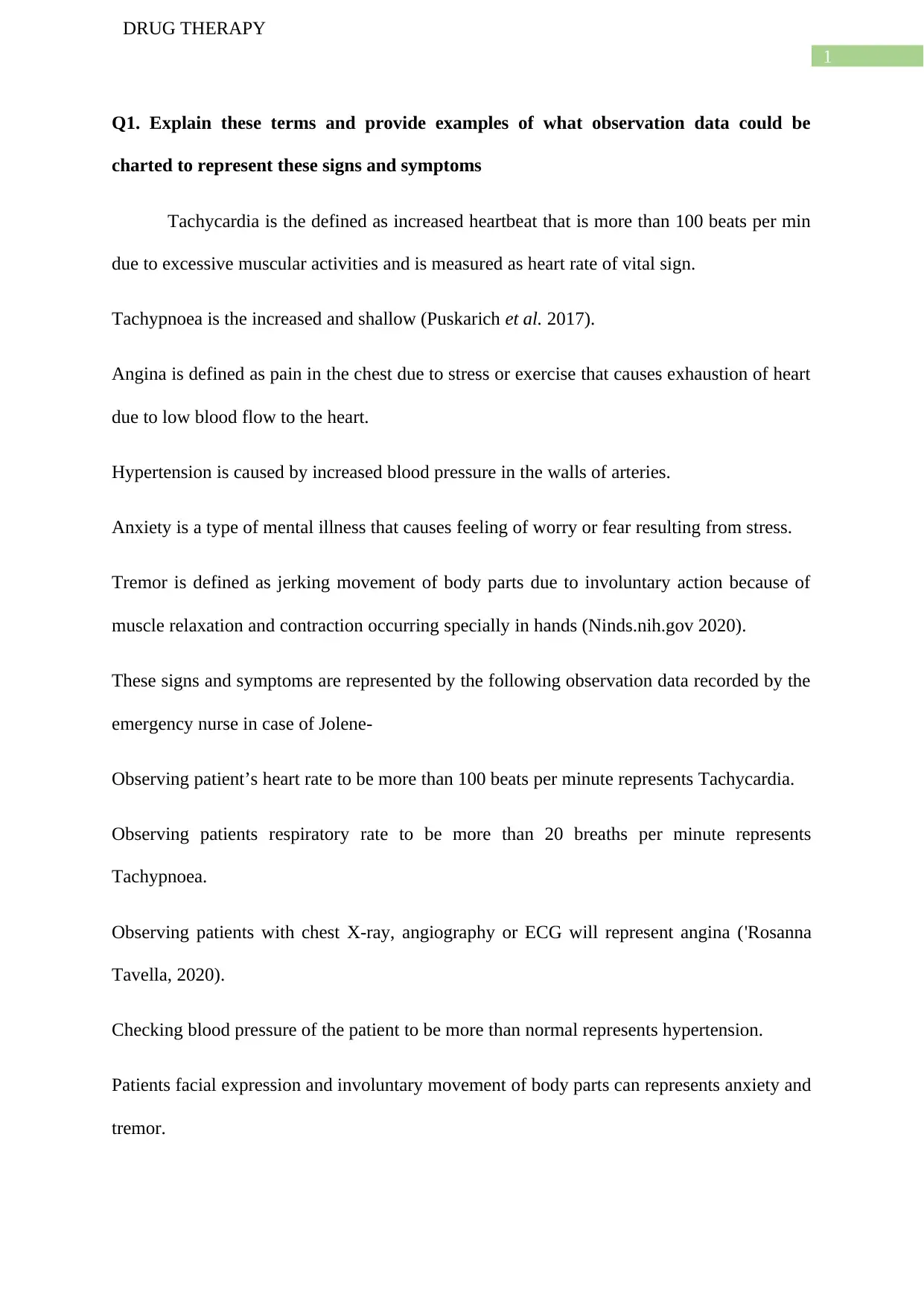
1
DRUG THERAPY
Q1. Explain these terms and provide examples of what observation data could be
charted to represent these signs and symptoms
Tachycardia is the defined as increased heartbeat that is more than 100 beats per min
due to excessive muscular activities and is measured as heart rate of vital sign.
Tachypnoea is the increased and shallow (Puskarich et al. 2017).
Angina is defined as pain in the chest due to stress or exercise that causes exhaustion of heart
due to low blood flow to the heart.
Hypertension is caused by increased blood pressure in the walls of arteries.
Anxiety is a type of mental illness that causes feeling of worry or fear resulting from stress.
Tremor is defined as jerking movement of body parts due to involuntary action because of
muscle relaxation and contraction occurring specially in hands (Ninds.nih.gov 2020).
These signs and symptoms are represented by the following observation data recorded by the
emergency nurse in case of Jolene-
Observing patient’s heart rate to be more than 100 beats per minute represents Tachycardia.
Observing patients respiratory rate to be more than 20 breaths per minute represents
Tachypnoea.
Observing patients with chest X-ray, angiography or ECG will represent angina ('Rosanna
Tavella, 2020).
Checking blood pressure of the patient to be more than normal represents hypertension.
Patients facial expression and involuntary movement of body parts can represents anxiety and
tremor.
DRUG THERAPY
Q1. Explain these terms and provide examples of what observation data could be
charted to represent these signs and symptoms
Tachycardia is the defined as increased heartbeat that is more than 100 beats per min
due to excessive muscular activities and is measured as heart rate of vital sign.
Tachypnoea is the increased and shallow (Puskarich et al. 2017).
Angina is defined as pain in the chest due to stress or exercise that causes exhaustion of heart
due to low blood flow to the heart.
Hypertension is caused by increased blood pressure in the walls of arteries.
Anxiety is a type of mental illness that causes feeling of worry or fear resulting from stress.
Tremor is defined as jerking movement of body parts due to involuntary action because of
muscle relaxation and contraction occurring specially in hands (Ninds.nih.gov 2020).
These signs and symptoms are represented by the following observation data recorded by the
emergency nurse in case of Jolene-
Observing patient’s heart rate to be more than 100 beats per minute represents Tachycardia.
Observing patients respiratory rate to be more than 20 breaths per minute represents
Tachypnoea.
Observing patients with chest X-ray, angiography or ECG will represent angina ('Rosanna
Tavella, 2020).
Checking blood pressure of the patient to be more than normal represents hypertension.
Patients facial expression and involuntary movement of body parts can represents anxiety and
tremor.
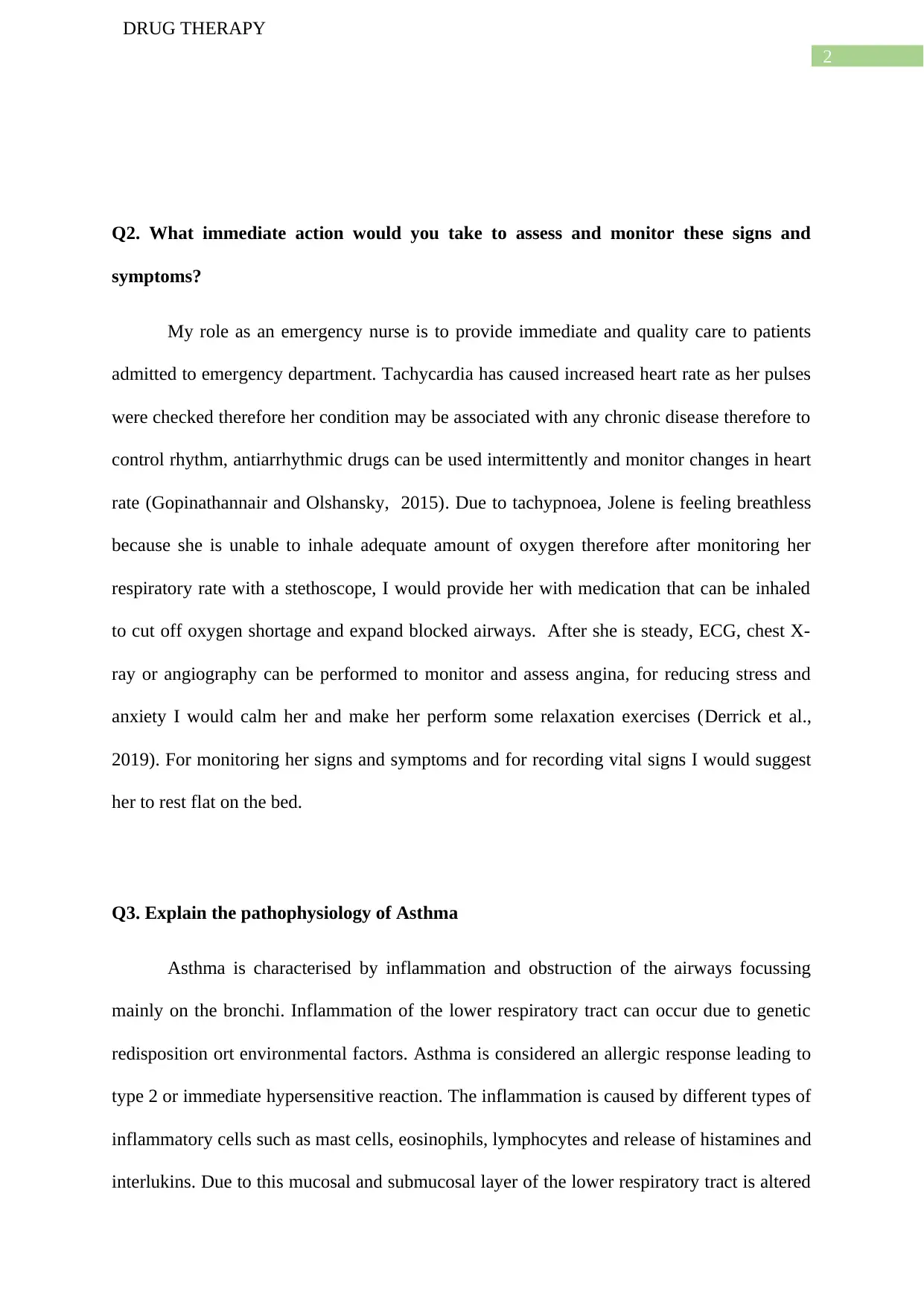
2
DRUG THERAPY
Q2. What immediate action would you take to assess and monitor these signs and
symptoms?
My role as an emergency nurse is to provide immediate and quality care to patients
admitted to emergency department. Tachycardia has caused increased heart rate as her pulses
were checked therefore her condition may be associated with any chronic disease therefore to
control rhythm, antiarrhythmic drugs can be used intermittently and monitor changes in heart
rate (Gopinathannair and Olshansky, 2015). Due to tachypnoea, Jolene is feeling breathless
because she is unable to inhale adequate amount of oxygen therefore after monitoring her
respiratory rate with a stethoscope, I would provide her with medication that can be inhaled
to cut off oxygen shortage and expand blocked airways. After she is steady, ECG, chest X-
ray or angiography can be performed to monitor and assess angina, for reducing stress and
anxiety I would calm her and make her perform some relaxation exercises (Derrick et al.,
2019). For monitoring her signs and symptoms and for recording vital signs I would suggest
her to rest flat on the bed.
Q3. Explain the pathophysiology of Asthma
Asthma is characterised by inflammation and obstruction of the airways focussing
mainly on the bronchi. Inflammation of the lower respiratory tract can occur due to genetic
redisposition ort environmental factors. Asthma is considered an allergic response leading to
type 2 or immediate hypersensitive reaction. The inflammation is caused by different types of
inflammatory cells such as mast cells, eosinophils, lymphocytes and release of histamines and
interlukins. Due to this mucosal and submucosal layer of the lower respiratory tract is altered
DRUG THERAPY
Q2. What immediate action would you take to assess and monitor these signs and
symptoms?
My role as an emergency nurse is to provide immediate and quality care to patients
admitted to emergency department. Tachycardia has caused increased heart rate as her pulses
were checked therefore her condition may be associated with any chronic disease therefore to
control rhythm, antiarrhythmic drugs can be used intermittently and monitor changes in heart
rate (Gopinathannair and Olshansky, 2015). Due to tachypnoea, Jolene is feeling breathless
because she is unable to inhale adequate amount of oxygen therefore after monitoring her
respiratory rate with a stethoscope, I would provide her with medication that can be inhaled
to cut off oxygen shortage and expand blocked airways. After she is steady, ECG, chest X-
ray or angiography can be performed to monitor and assess angina, for reducing stress and
anxiety I would calm her and make her perform some relaxation exercises (Derrick et al.,
2019). For monitoring her signs and symptoms and for recording vital signs I would suggest
her to rest flat on the bed.
Q3. Explain the pathophysiology of Asthma
Asthma is characterised by inflammation and obstruction of the airways focussing
mainly on the bronchi. Inflammation of the lower respiratory tract can occur due to genetic
redisposition ort environmental factors. Asthma is considered an allergic response leading to
type 2 or immediate hypersensitive reaction. The inflammation is caused by different types of
inflammatory cells such as mast cells, eosinophils, lymphocytes and release of histamines and
interlukins. Due to this mucosal and submucosal layer of the lower respiratory tract is altered
⊘ This is a preview!⊘
Do you want full access?
Subscribe today to unlock all pages.

Trusted by 1+ million students worldwide
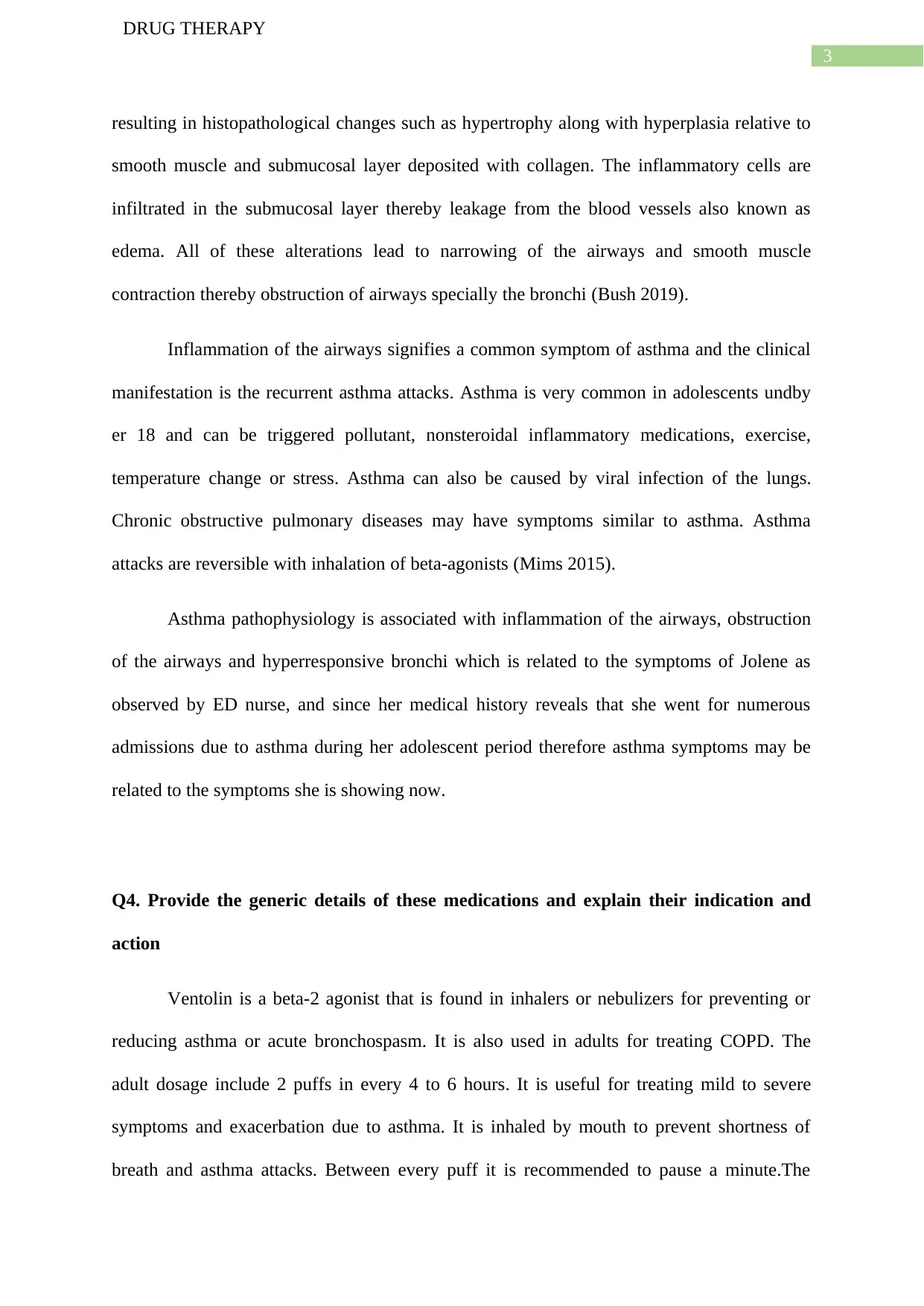
3
DRUG THERAPY
resulting in histopathological changes such as hypertrophy along with hyperplasia relative to
smooth muscle and submucosal layer deposited with collagen. The inflammatory cells are
infiltrated in the submucosal layer thereby leakage from the blood vessels also known as
edema. All of these alterations lead to narrowing of the airways and smooth muscle
contraction thereby obstruction of airways specially the bronchi (Bush 2019).
Inflammation of the airways signifies a common symptom of asthma and the clinical
manifestation is the recurrent asthma attacks. Asthma is very common in adolescents undby
er 18 and can be triggered pollutant, nonsteroidal inflammatory medications, exercise,
temperature change or stress. Asthma can also be caused by viral infection of the lungs.
Chronic obstructive pulmonary diseases may have symptoms similar to asthma. Asthma
attacks are reversible with inhalation of beta-agonists (Mims 2015).
Asthma pathophysiology is associated with inflammation of the airways, obstruction
of the airways and hyperresponsive bronchi which is related to the symptoms of Jolene as
observed by ED nurse, and since her medical history reveals that she went for numerous
admissions due to asthma during her adolescent period therefore asthma symptoms may be
related to the symptoms she is showing now.
Q4. Provide the generic details of these medications and explain their indication and
action
Ventolin is a beta-2 agonist that is found in inhalers or nebulizers for preventing or
reducing asthma or acute bronchospasm. It is also used in adults for treating COPD. The
adult dosage include 2 puffs in every 4 to 6 hours. It is useful for treating mild to severe
symptoms and exacerbation due to asthma. It is inhaled by mouth to prevent shortness of
breath and asthma attacks. Between every puff it is recommended to pause a minute.The
DRUG THERAPY
resulting in histopathological changes such as hypertrophy along with hyperplasia relative to
smooth muscle and submucosal layer deposited with collagen. The inflammatory cells are
infiltrated in the submucosal layer thereby leakage from the blood vessels also known as
edema. All of these alterations lead to narrowing of the airways and smooth muscle
contraction thereby obstruction of airways specially the bronchi (Bush 2019).
Inflammation of the airways signifies a common symptom of asthma and the clinical
manifestation is the recurrent asthma attacks. Asthma is very common in adolescents undby
er 18 and can be triggered pollutant, nonsteroidal inflammatory medications, exercise,
temperature change or stress. Asthma can also be caused by viral infection of the lungs.
Chronic obstructive pulmonary diseases may have symptoms similar to asthma. Asthma
attacks are reversible with inhalation of beta-agonists (Mims 2015).
Asthma pathophysiology is associated with inflammation of the airways, obstruction
of the airways and hyperresponsive bronchi which is related to the symptoms of Jolene as
observed by ED nurse, and since her medical history reveals that she went for numerous
admissions due to asthma during her adolescent period therefore asthma symptoms may be
related to the symptoms she is showing now.
Q4. Provide the generic details of these medications and explain their indication and
action
Ventolin is a beta-2 agonist that is found in inhalers or nebulizers for preventing or
reducing asthma or acute bronchospasm. It is also used in adults for treating COPD. The
adult dosage include 2 puffs in every 4 to 6 hours. It is useful for treating mild to severe
symptoms and exacerbation due to asthma. It is inhaled by mouth to prevent shortness of
breath and asthma attacks. Between every puff it is recommended to pause a minute.The
Paraphrase This Document
Need a fresh take? Get an instant paraphrase of this document with our AI Paraphraser
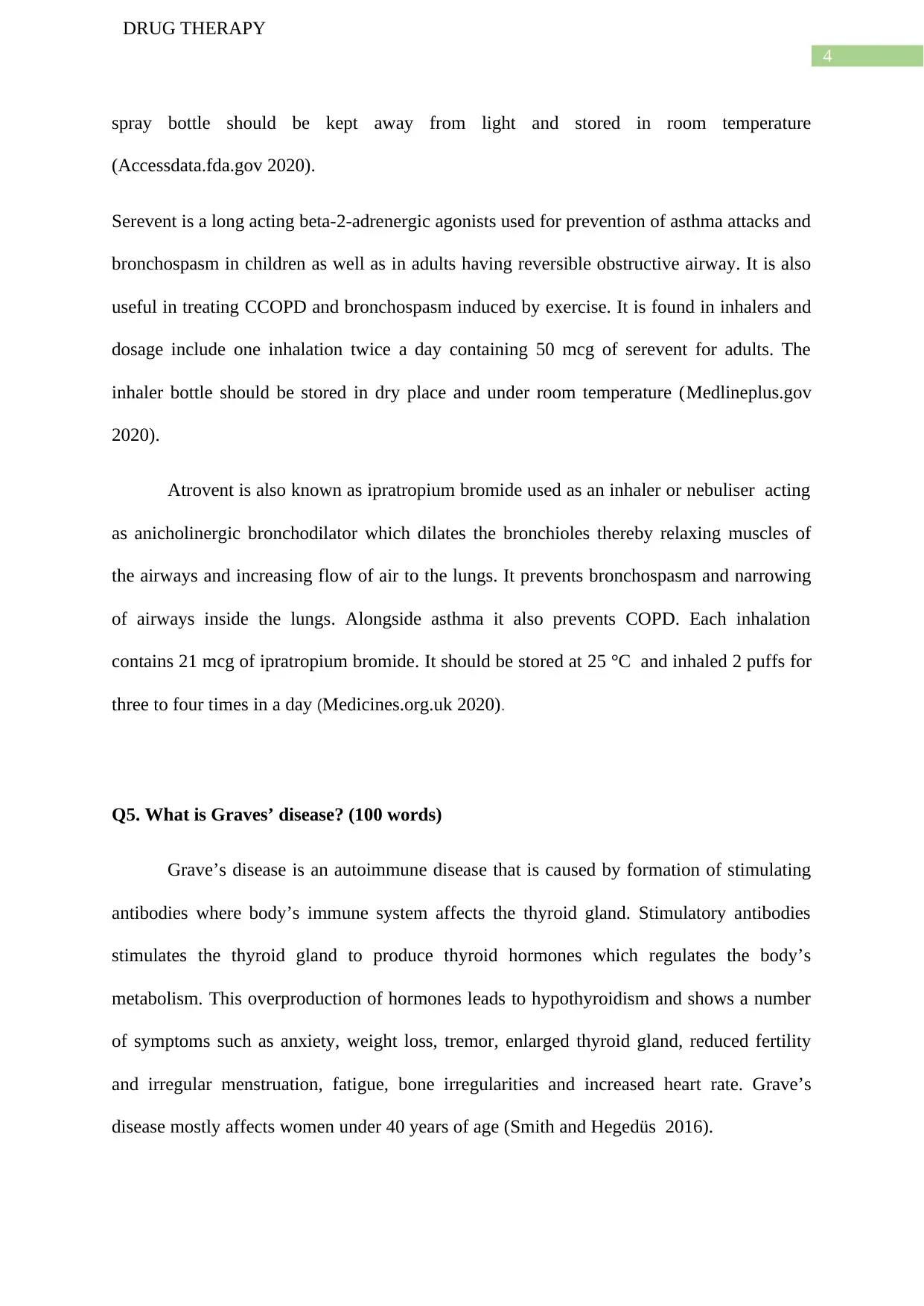
4
DRUG THERAPY
spray bottle should be kept away from light and stored in room temperature
(Accessdata.fda.gov 2020).
Serevent is a long acting beta-2-adrenergic agonists used for prevention of asthma attacks and
bronchospasm in children as well as in adults having reversible obstructive airway. It is also
useful in treating CCOPD and bronchospasm induced by exercise. It is found in inhalers and
dosage include one inhalation twice a day containing 50 mcg of serevent for adults. The
inhaler bottle should be stored in dry place and under room temperature (Medlineplus.gov
2020).
Atrovent is also known as ipratropium bromide used as an inhaler or nebuliser acting
as anicholinergic bronchodilator which dilates the bronchioles thereby relaxing muscles of
the airways and increasing flow of air to the lungs. It prevents bronchospasm and narrowing
of airways inside the lungs. Alongside asthma it also prevents COPD. Each inhalation
contains 21 mcg of ipratropium bromide. It should be stored at 25 °C and inhaled 2 puffs for
three to four times in a day (Medicines.org.uk 2020).
Q5. What is Graves’ disease? (100 words)
Grave’s disease is an autoimmune disease that is caused by formation of stimulating
antibodies where body’s immune system affects the thyroid gland. Stimulatory antibodies
stimulates the thyroid gland to produce thyroid hormones which regulates the body’s
metabolism. This overproduction of hormones leads to hypothyroidism and shows a number
of symptoms such as anxiety, weight loss, tremor, enlarged thyroid gland, reduced fertility
and irregular menstruation, fatigue, bone irregularities and increased heart rate. Grave’s
disease mostly affects women under 40 years of age (Smith and Hegedüs 2016).
DRUG THERAPY
spray bottle should be kept away from light and stored in room temperature
(Accessdata.fda.gov 2020).
Serevent is a long acting beta-2-adrenergic agonists used for prevention of asthma attacks and
bronchospasm in children as well as in adults having reversible obstructive airway. It is also
useful in treating CCOPD and bronchospasm induced by exercise. It is found in inhalers and
dosage include one inhalation twice a day containing 50 mcg of serevent for adults. The
inhaler bottle should be stored in dry place and under room temperature (Medlineplus.gov
2020).
Atrovent is also known as ipratropium bromide used as an inhaler or nebuliser acting
as anicholinergic bronchodilator which dilates the bronchioles thereby relaxing muscles of
the airways and increasing flow of air to the lungs. It prevents bronchospasm and narrowing
of airways inside the lungs. Alongside asthma it also prevents COPD. Each inhalation
contains 21 mcg of ipratropium bromide. It should be stored at 25 °C and inhaled 2 puffs for
three to four times in a day (Medicines.org.uk 2020).
Q5. What is Graves’ disease? (100 words)
Grave’s disease is an autoimmune disease that is caused by formation of stimulating
antibodies where body’s immune system affects the thyroid gland. Stimulatory antibodies
stimulates the thyroid gland to produce thyroid hormones which regulates the body’s
metabolism. This overproduction of hormones leads to hypothyroidism and shows a number
of symptoms such as anxiety, weight loss, tremor, enlarged thyroid gland, reduced fertility
and irregular menstruation, fatigue, bone irregularities and increased heart rate. Grave’s
disease mostly affects women under 40 years of age (Smith and Hegedüs 2016).

5
DRUG THERAPY
Q6. Describe antithyroid drug treatment for Graves’ disease (150 words)
Treatment for Grave’s disease involve use of antithyroid drugs that reduces the
production of thyroid hormones. There is no permanent cure for this diseases however certain
drugs lasts its effect for a long time such as methimazole and propylthiouracil. There are
different doses for different levels of hypothyroidism. Patients who have mild
hypothyroidism are given a dose of 10-15 mg of methimazole everyday while patients with
severity are given 20-40 mg of methimazole every day. The antithyroid drug is administered
in two steps- firstly the drug is given for 6- 8 months after which the level of TSH is
monitored, if TSH is under normal range then the treatment is stopped there. A long term
antithyroid drug treatment is given for those who severe hypothyroidism. However studies
show that a long term treatment with low dosage of antithyroid drug can be effective in
preventing the recurrence of this disease (Liu et al. 2017). In most cases of Australia,
antithyroid drug effects begins after 2-4 weeks of administration where normal function of
thyroid gland is achieved (Racgp.org.au 2020).
Q7. Explain the rationale for this combination of drug therapy and discuss the
interactions with the bronchodilators already used (200 words).
Beta-blockers are not inhibitors of overproduction of thyroid hormones but they show
their effectivity by reducing the symptoms as long as the antithyroid drug takes time to show
its effect. Beta-blockers alleviate the symptoms caused by hyperthyroidism such as
palpitation, tachycardia, tremor and intolerance to heat. The beta-blockers are administered as
soon as the hyperthyroidism is detected for reducing the effect of beta-adrenergic that
increases during Grave’s disease leading to the symptoms stated. Studies show that beta-
DRUG THERAPY
Q6. Describe antithyroid drug treatment for Graves’ disease (150 words)
Treatment for Grave’s disease involve use of antithyroid drugs that reduces the
production of thyroid hormones. There is no permanent cure for this diseases however certain
drugs lasts its effect for a long time such as methimazole and propylthiouracil. There are
different doses for different levels of hypothyroidism. Patients who have mild
hypothyroidism are given a dose of 10-15 mg of methimazole everyday while patients with
severity are given 20-40 mg of methimazole every day. The antithyroid drug is administered
in two steps- firstly the drug is given for 6- 8 months after which the level of TSH is
monitored, if TSH is under normal range then the treatment is stopped there. A long term
antithyroid drug treatment is given for those who severe hypothyroidism. However studies
show that a long term treatment with low dosage of antithyroid drug can be effective in
preventing the recurrence of this disease (Liu et al. 2017). In most cases of Australia,
antithyroid drug effects begins after 2-4 weeks of administration where normal function of
thyroid gland is achieved (Racgp.org.au 2020).
Q7. Explain the rationale for this combination of drug therapy and discuss the
interactions with the bronchodilators already used (200 words).
Beta-blockers are not inhibitors of overproduction of thyroid hormones but they show
their effectivity by reducing the symptoms as long as the antithyroid drug takes time to show
its effect. Beta-blockers alleviate the symptoms caused by hyperthyroidism such as
palpitation, tachycardia, tremor and intolerance to heat. The beta-blockers are administered as
soon as the hyperthyroidism is detected for reducing the effect of beta-adrenergic that
increases during Grave’s disease leading to the symptoms stated. Studies show that beta-
⊘ This is a preview!⊘
Do you want full access?
Subscribe today to unlock all pages.

Trusted by 1+ million students worldwide
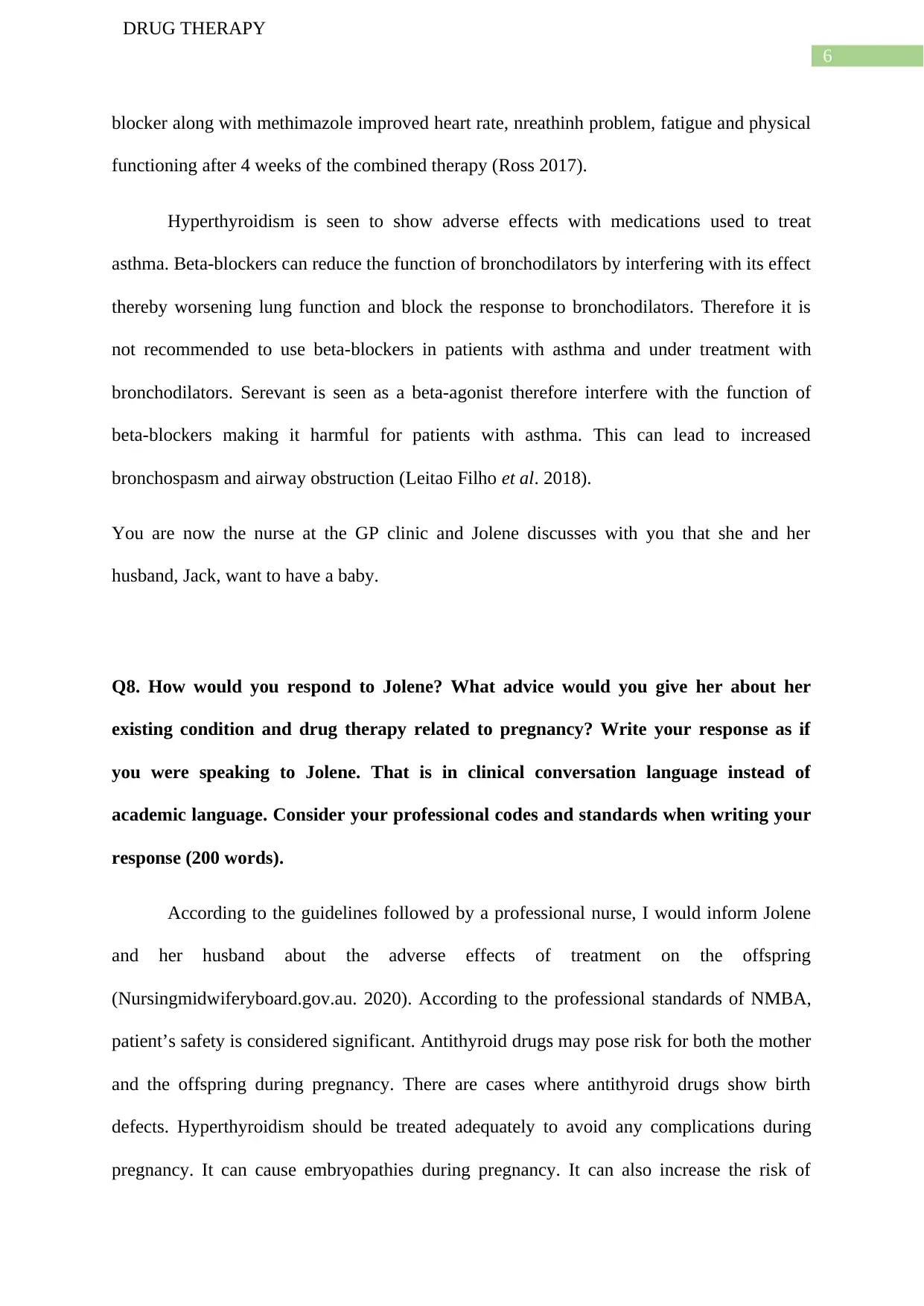
6
DRUG THERAPY
blocker along with methimazole improved heart rate, nreathinh problem, fatigue and physical
functioning after 4 weeks of the combined therapy (Ross 2017).
Hyperthyroidism is seen to show adverse effects with medications used to treat
asthma. Beta-blockers can reduce the function of bronchodilators by interfering with its effect
thereby worsening lung function and block the response to bronchodilators. Therefore it is
not recommended to use beta-blockers in patients with asthma and under treatment with
bronchodilators. Serevant is seen as a beta-agonist therefore interfere with the function of
beta-blockers making it harmful for patients with asthma. This can lead to increased
bronchospasm and airway obstruction (Leitao Filho et al. 2018).
You are now the nurse at the GP clinic and Jolene discusses with you that she and her
husband, Jack, want to have a baby.
Q8. How would you respond to Jolene? What advice would you give her about her
existing condition and drug therapy related to pregnancy? Write your response as if
you were speaking to Jolene. That is in clinical conversation language instead of
academic language. Consider your professional codes and standards when writing your
response (200 words).
According to the guidelines followed by a professional nurse, I would inform Jolene
and her husband about the adverse effects of treatment on the offspring
(Nursingmidwiferyboard.gov.au. 2020). According to the professional standards of NMBA,
patient’s safety is considered significant. Antithyroid drugs may pose risk for both the mother
and the offspring during pregnancy. There are cases where antithyroid drugs show birth
defects. Hyperthyroidism should be treated adequately to avoid any complications during
pregnancy. It can cause embryopathies during pregnancy. It can also increase the risk of
DRUG THERAPY
blocker along with methimazole improved heart rate, nreathinh problem, fatigue and physical
functioning after 4 weeks of the combined therapy (Ross 2017).
Hyperthyroidism is seen to show adverse effects with medications used to treat
asthma. Beta-blockers can reduce the function of bronchodilators by interfering with its effect
thereby worsening lung function and block the response to bronchodilators. Therefore it is
not recommended to use beta-blockers in patients with asthma and under treatment with
bronchodilators. Serevant is seen as a beta-agonist therefore interfere with the function of
beta-blockers making it harmful for patients with asthma. This can lead to increased
bronchospasm and airway obstruction (Leitao Filho et al. 2018).
You are now the nurse at the GP clinic and Jolene discusses with you that she and her
husband, Jack, want to have a baby.
Q8. How would you respond to Jolene? What advice would you give her about her
existing condition and drug therapy related to pregnancy? Write your response as if
you were speaking to Jolene. That is in clinical conversation language instead of
academic language. Consider your professional codes and standards when writing your
response (200 words).
According to the guidelines followed by a professional nurse, I would inform Jolene
and her husband about the adverse effects of treatment on the offspring
(Nursingmidwiferyboard.gov.au. 2020). According to the professional standards of NMBA,
patient’s safety is considered significant. Antithyroid drugs may pose risk for both the mother
and the offspring during pregnancy. There are cases where antithyroid drugs show birth
defects. Hyperthyroidism should be treated adequately to avoid any complications during
pregnancy. It can cause embryopathies during pregnancy. It can also increase the risk of
Paraphrase This Document
Need a fresh take? Get an instant paraphrase of this document with our AI Paraphraser
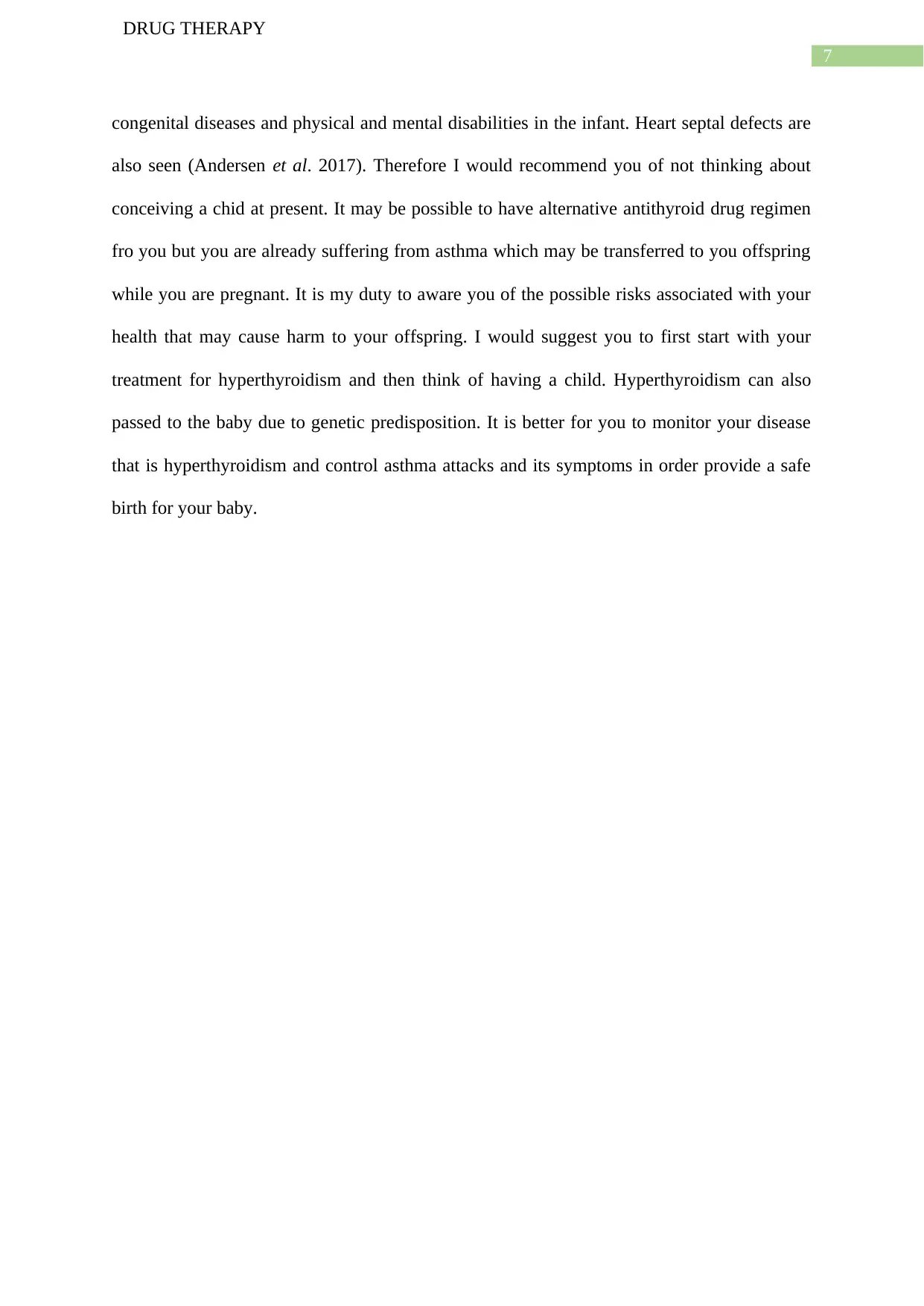
7
DRUG THERAPY
congenital diseases and physical and mental disabilities in the infant. Heart septal defects are
also seen (Andersen et al. 2017). Therefore I would recommend you of not thinking about
conceiving a chid at present. It may be possible to have alternative antithyroid drug regimen
fro you but you are already suffering from asthma which may be transferred to you offspring
while you are pregnant. It is my duty to aware you of the possible risks associated with your
health that may cause harm to your offspring. I would suggest you to first start with your
treatment for hyperthyroidism and then think of having a child. Hyperthyroidism can also
passed to the baby due to genetic predisposition. It is better for you to monitor your disease
that is hyperthyroidism and control asthma attacks and its symptoms in order provide a safe
birth for your baby.
DRUG THERAPY
congenital diseases and physical and mental disabilities in the infant. Heart septal defects are
also seen (Andersen et al. 2017). Therefore I would recommend you of not thinking about
conceiving a chid at present. It may be possible to have alternative antithyroid drug regimen
fro you but you are already suffering from asthma which may be transferred to you offspring
while you are pregnant. It is my duty to aware you of the possible risks associated with your
health that may cause harm to your offspring. I would suggest you to first start with your
treatment for hyperthyroidism and then think of having a child. Hyperthyroidism can also
passed to the baby due to genetic predisposition. It is better for you to monitor your disease
that is hyperthyroidism and control asthma attacks and its symptoms in order provide a safe
birth for your baby.
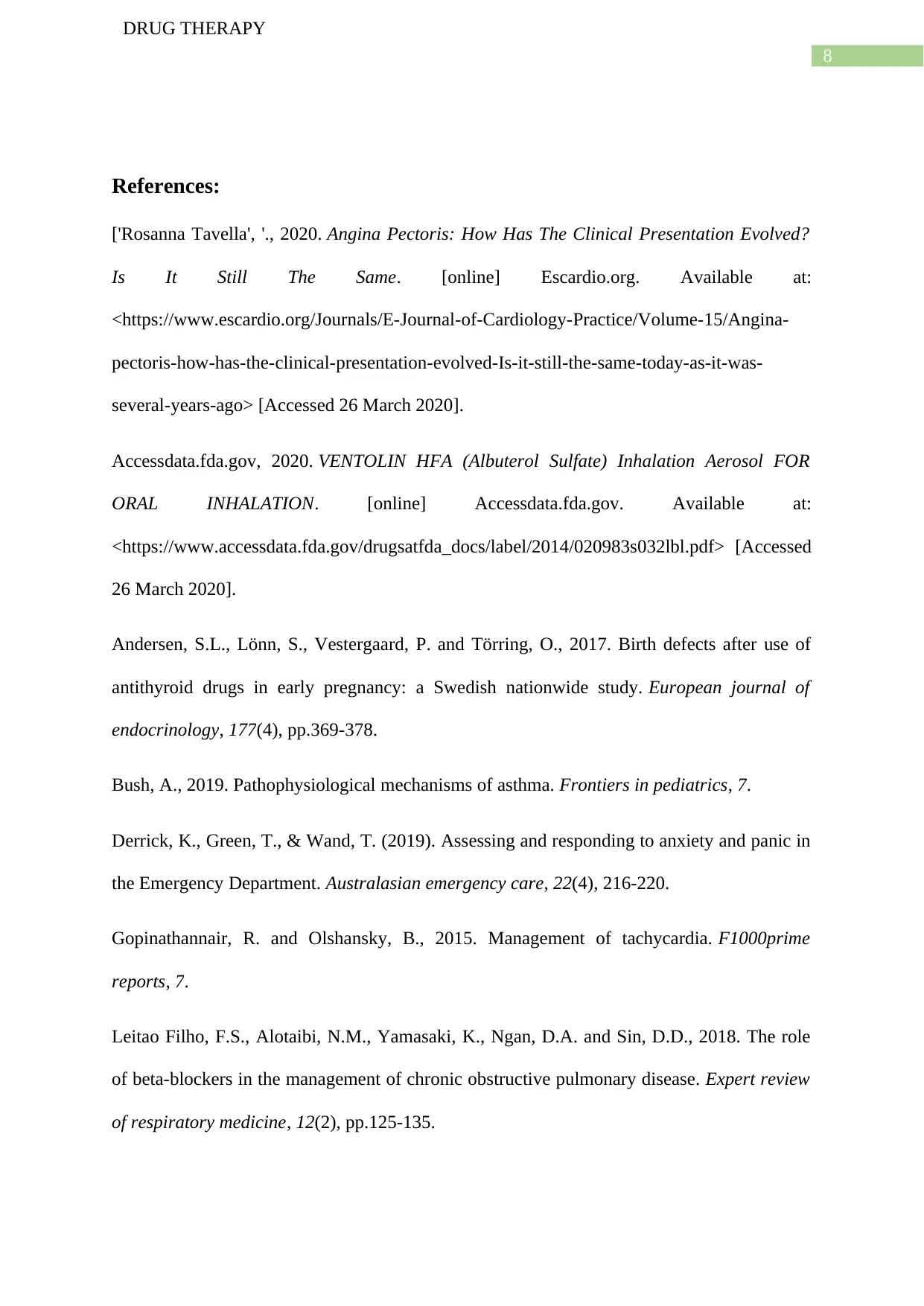
8
DRUG THERAPY
References:
['Rosanna Tavella', '., 2020. Angina Pectoris: How Has The Clinical Presentation Evolved?
Is It Still The Same. [online] Escardio.org. Available at:
<https://www.escardio.org/Journals/E-Journal-of-Cardiology-Practice/Volume-15/Angina-
pectoris-how-has-the-clinical-presentation-evolved-Is-it-still-the-same-today-as-it-was-
several-years-ago> [Accessed 26 March 2020].
Accessdata.fda.gov, 2020. VENTOLIN HFA (Albuterol Sulfate) Inhalation Aerosol FOR
ORAL INHALATION. [online] Accessdata.fda.gov. Available at:
<https://www.accessdata.fda.gov/drugsatfda_docs/label/2014/020983s032lbl.pdf> [Accessed
26 March 2020].
Andersen, S.L., Lönn, S., Vestergaard, P. and Törring, O., 2017. Birth defects after use of
antithyroid drugs in early pregnancy: a Swedish nationwide study. European journal of
endocrinology, 177(4), pp.369-378.
Bush, A., 2019. Pathophysiological mechanisms of asthma. Frontiers in pediatrics, 7.
Derrick, K., Green, T., & Wand, T. (2019). Assessing and responding to anxiety and panic in
the Emergency Department. Australasian emergency care, 22(4), 216-220.
Gopinathannair, R. and Olshansky, B., 2015. Management of tachycardia. F1000prime
reports, 7.
Leitao Filho, F.S., Alotaibi, N.M., Yamasaki, K., Ngan, D.A. and Sin, D.D., 2018. The role
of beta-blockers in the management of chronic obstructive pulmonary disease. Expert review
of respiratory medicine, 12(2), pp.125-135.
DRUG THERAPY
References:
['Rosanna Tavella', '., 2020. Angina Pectoris: How Has The Clinical Presentation Evolved?
Is It Still The Same. [online] Escardio.org. Available at:
<https://www.escardio.org/Journals/E-Journal-of-Cardiology-Practice/Volume-15/Angina-
pectoris-how-has-the-clinical-presentation-evolved-Is-it-still-the-same-today-as-it-was-
several-years-ago> [Accessed 26 March 2020].
Accessdata.fda.gov, 2020. VENTOLIN HFA (Albuterol Sulfate) Inhalation Aerosol FOR
ORAL INHALATION. [online] Accessdata.fda.gov. Available at:
<https://www.accessdata.fda.gov/drugsatfda_docs/label/2014/020983s032lbl.pdf> [Accessed
26 March 2020].
Andersen, S.L., Lönn, S., Vestergaard, P. and Törring, O., 2017. Birth defects after use of
antithyroid drugs in early pregnancy: a Swedish nationwide study. European journal of
endocrinology, 177(4), pp.369-378.
Bush, A., 2019. Pathophysiological mechanisms of asthma. Frontiers in pediatrics, 7.
Derrick, K., Green, T., & Wand, T. (2019). Assessing and responding to anxiety and panic in
the Emergency Department. Australasian emergency care, 22(4), 216-220.
Gopinathannair, R. and Olshansky, B., 2015. Management of tachycardia. F1000prime
reports, 7.
Leitao Filho, F.S., Alotaibi, N.M., Yamasaki, K., Ngan, D.A. and Sin, D.D., 2018. The role
of beta-blockers in the management of chronic obstructive pulmonary disease. Expert review
of respiratory medicine, 12(2), pp.125-135.
⊘ This is a preview!⊘
Do you want full access?
Subscribe today to unlock all pages.

Trusted by 1+ million students worldwide
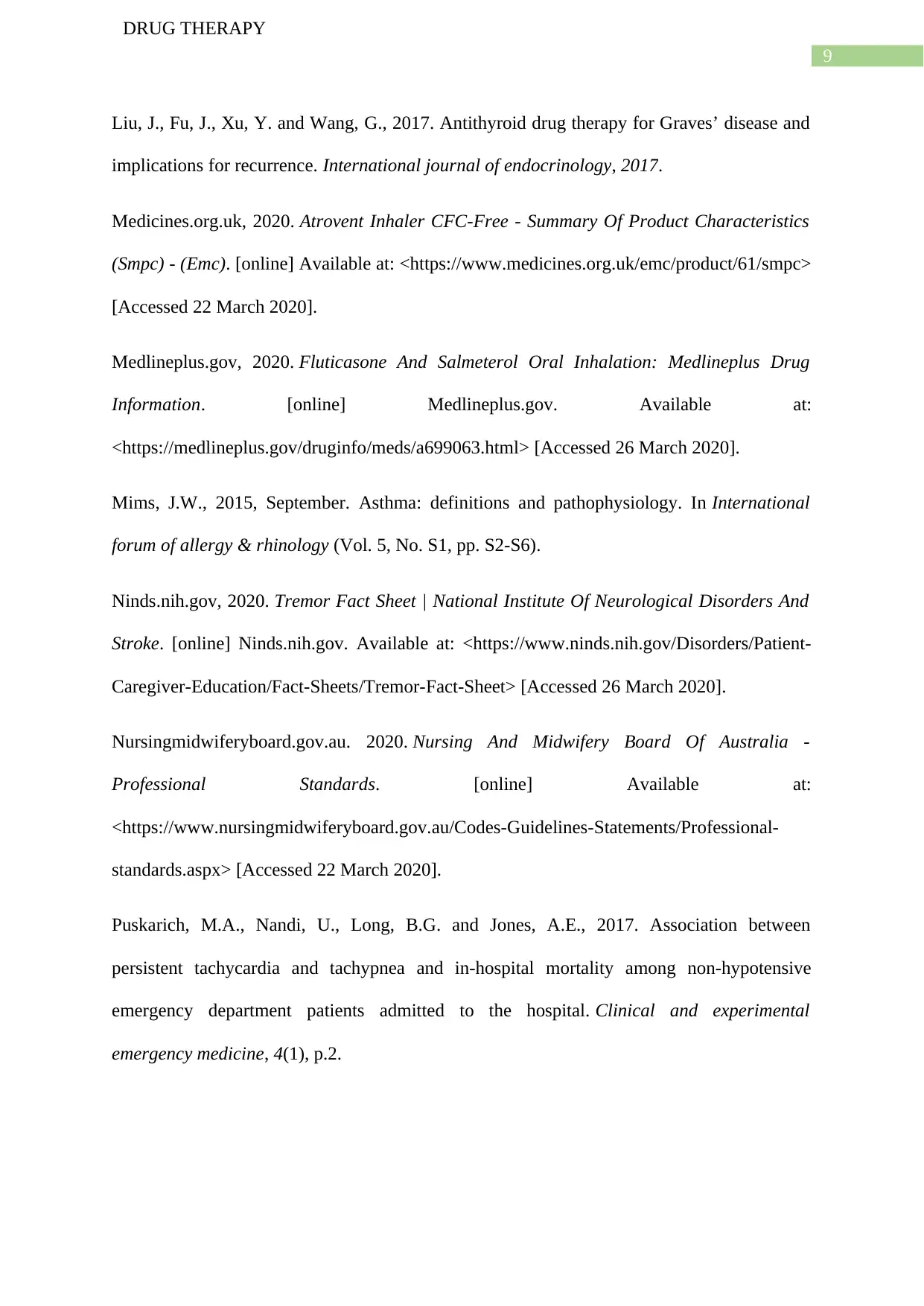
9
DRUG THERAPY
Liu, J., Fu, J., Xu, Y. and Wang, G., 2017. Antithyroid drug therapy for Graves’ disease and
implications for recurrence. International journal of endocrinology, 2017.
Medicines.org.uk, 2020. Atrovent Inhaler CFC-Free - Summary Of Product Characteristics
(Smpc) - (Emc). [online] Available at: <https://www.medicines.org.uk/emc/product/61/smpc>
[Accessed 22 March 2020].
Medlineplus.gov, 2020. Fluticasone And Salmeterol Oral Inhalation: Medlineplus Drug
Information. [online] Medlineplus.gov. Available at:
<https://medlineplus.gov/druginfo/meds/a699063.html> [Accessed 26 March 2020].
Mims, J.W., 2015, September. Asthma: definitions and pathophysiology. In International
forum of allergy & rhinology (Vol. 5, No. S1, pp. S2-S6).
Ninds.nih.gov, 2020. Tremor Fact Sheet | National Institute Of Neurological Disorders And
Stroke. [online] Ninds.nih.gov. Available at: <https://www.ninds.nih.gov/Disorders/Patient-
Caregiver-Education/Fact-Sheets/Tremor-Fact-Sheet> [Accessed 26 March 2020].
Nursingmidwiferyboard.gov.au. 2020. Nursing And Midwifery Board Of Australia -
Professional Standards. [online] Available at:
<https://www.nursingmidwiferyboard.gov.au/Codes-Guidelines-Statements/Professional-
standards.aspx> [Accessed 22 March 2020].
Puskarich, M.A., Nandi, U., Long, B.G. and Jones, A.E., 2017. Association between
persistent tachycardia and tachypnea and in-hospital mortality among non-hypotensive
emergency department patients admitted to the hospital. Clinical and experimental
emergency medicine, 4(1), p.2.
DRUG THERAPY
Liu, J., Fu, J., Xu, Y. and Wang, G., 2017. Antithyroid drug therapy for Graves’ disease and
implications for recurrence. International journal of endocrinology, 2017.
Medicines.org.uk, 2020. Atrovent Inhaler CFC-Free - Summary Of Product Characteristics
(Smpc) - (Emc). [online] Available at: <https://www.medicines.org.uk/emc/product/61/smpc>
[Accessed 22 March 2020].
Medlineplus.gov, 2020. Fluticasone And Salmeterol Oral Inhalation: Medlineplus Drug
Information. [online] Medlineplus.gov. Available at:
<https://medlineplus.gov/druginfo/meds/a699063.html> [Accessed 26 March 2020].
Mims, J.W., 2015, September. Asthma: definitions and pathophysiology. In International
forum of allergy & rhinology (Vol. 5, No. S1, pp. S2-S6).
Ninds.nih.gov, 2020. Tremor Fact Sheet | National Institute Of Neurological Disorders And
Stroke. [online] Ninds.nih.gov. Available at: <https://www.ninds.nih.gov/Disorders/Patient-
Caregiver-Education/Fact-Sheets/Tremor-Fact-Sheet> [Accessed 26 March 2020].
Nursingmidwiferyboard.gov.au. 2020. Nursing And Midwifery Board Of Australia -
Professional Standards. [online] Available at:
<https://www.nursingmidwiferyboard.gov.au/Codes-Guidelines-Statements/Professional-
standards.aspx> [Accessed 22 March 2020].
Puskarich, M.A., Nandi, U., Long, B.G. and Jones, A.E., 2017. Association between
persistent tachycardia and tachypnea and in-hospital mortality among non-hypotensive
emergency department patients admitted to the hospital. Clinical and experimental
emergency medicine, 4(1), p.2.
Paraphrase This Document
Need a fresh take? Get an instant paraphrase of this document with our AI Paraphraser
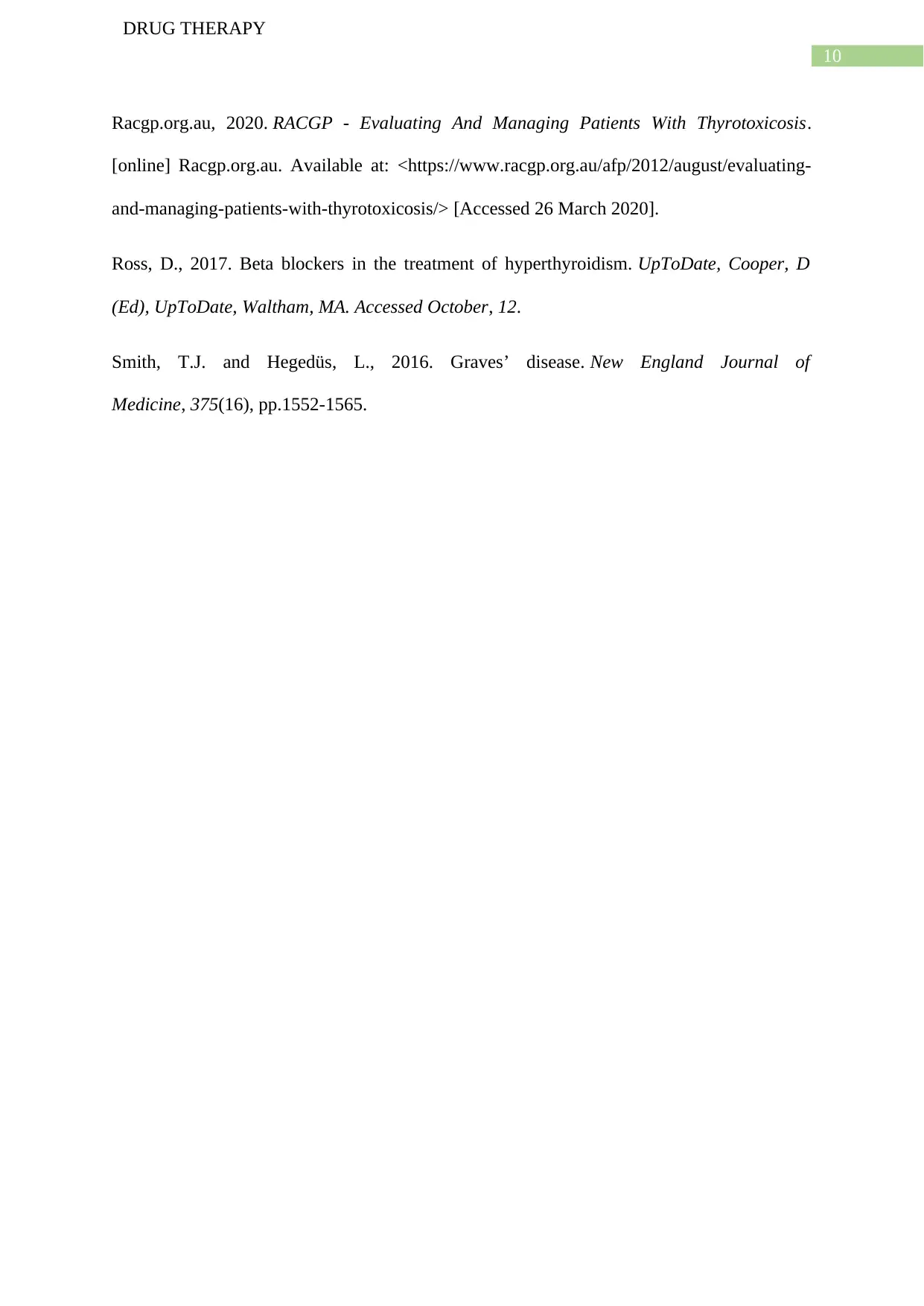
10
DRUG THERAPY
Racgp.org.au, 2020. RACGP - Evaluating And Managing Patients With Thyrotoxicosis.
[online] Racgp.org.au. Available at: <https://www.racgp.org.au/afp/2012/august/evaluating-
and-managing-patients-with-thyrotoxicosis/> [Accessed 26 March 2020].
Ross, D., 2017. Beta blockers in the treatment of hyperthyroidism. UpToDate, Cooper, D
(Ed), UpToDate, Waltham, MA. Accessed October, 12.
Smith, T.J. and Hegedüs, L., 2016. Graves’ disease. New England Journal of
Medicine, 375(16), pp.1552-1565.
DRUG THERAPY
Racgp.org.au, 2020. RACGP - Evaluating And Managing Patients With Thyrotoxicosis.
[online] Racgp.org.au. Available at: <https://www.racgp.org.au/afp/2012/august/evaluating-
and-managing-patients-with-thyrotoxicosis/> [Accessed 26 March 2020].
Ross, D., 2017. Beta blockers in the treatment of hyperthyroidism. UpToDate, Cooper, D
(Ed), UpToDate, Waltham, MA. Accessed October, 12.
Smith, T.J. and Hegedüs, L., 2016. Graves’ disease. New England Journal of
Medicine, 375(16), pp.1552-1565.
1 out of 11
Related Documents
Your All-in-One AI-Powered Toolkit for Academic Success.
+13062052269
info@desklib.com
Available 24*7 on WhatsApp / Email
![[object Object]](/_next/static/media/star-bottom.7253800d.svg)
Unlock your academic potential
Copyright © 2020–2025 A2Z Services. All Rights Reserved. Developed and managed by ZUCOL.





